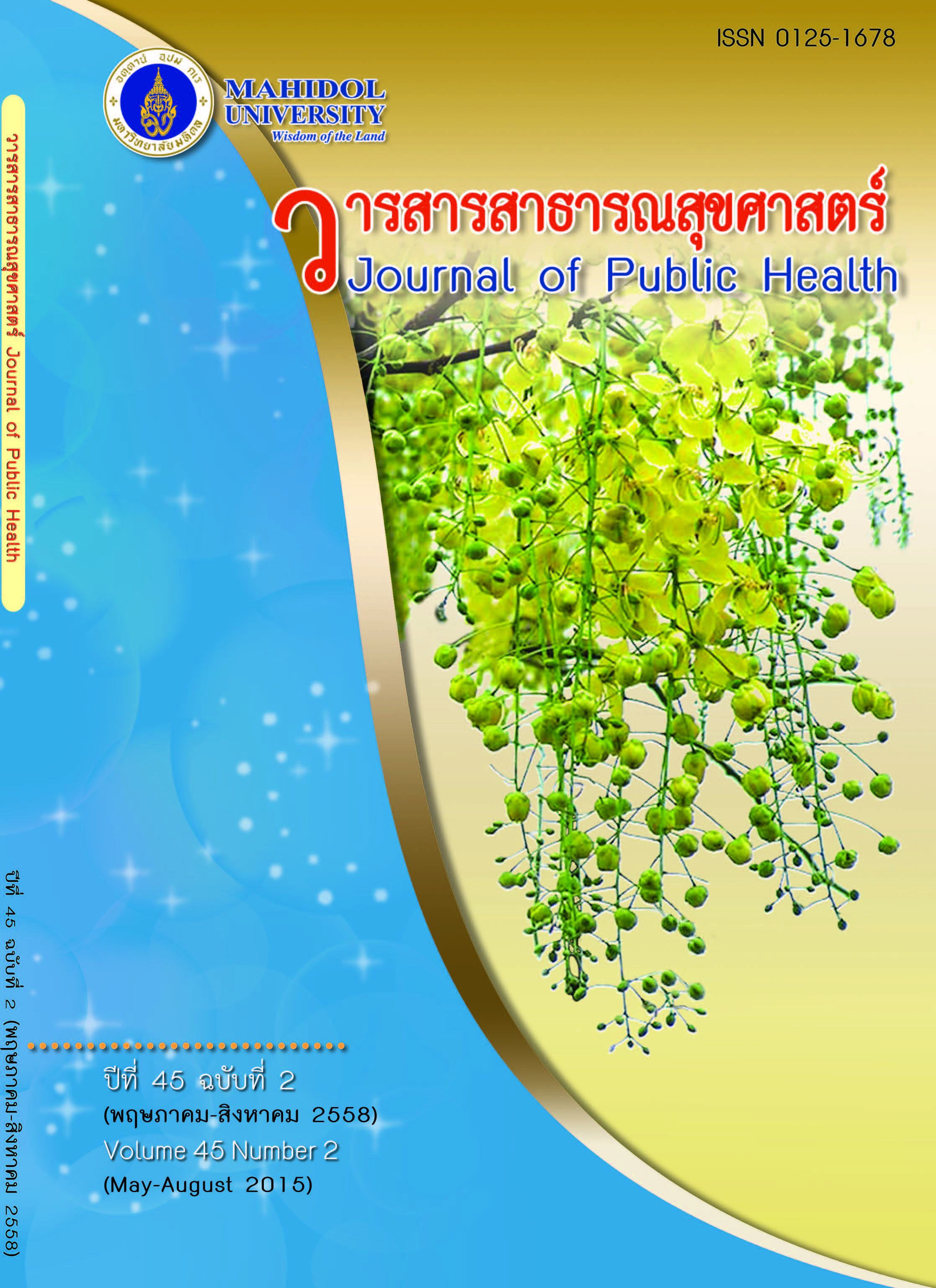การประเมินความเสี่ยงต่อสุขภาพของการได้รับสัมผัสแอมโมเนียของพนักงานสหกรณ์กองทุนสวนยางในเขตภาคใต้
Keywords:
การประเมินความเสี่ยงต่อสุขภาพ, การประเมินการได้รับสัมผัส, แอมโมเนีย, สหกรณ์กองทุนสวนยางAbstract
บทคัดย่อ
พนักงานรับซื้อน้ำยางสดในสหกรณ์กองทุนสวนยางมีการใช้แอมโมเนียในปริมาณมากเพื่อรักษาสภาพน้ำยางซึ่งอาจทำให้มีความเสี่ยงต่อสุขภาพได้ งานวิจัยนี้จึงมีวัตถุประสงค์เพื่อประเมินความเสี่ยงต่อสุขภาพจากการได้รับสัมผัสแอมโมเนียของพนักงานสหกรณ์กองทุนสวนยางในภาคใต้ ทำการเก็บตัวอย่างแอมโมเนียจากพนักงาน 55 คน และพื้นที่ทำงาน 15 แห่ง และประเมินความเสี่ยงทางสุขภาพจากการสัมผัส 2 วิธี คือ ทางด้านอาชีวอนามัยและตามแบบองค์กรพิทักษ์สิ่งแวดล้อมของประเทศสหรัฐอเมริกา ผลการศึกษา พบว่ากลุ่มตัวอย่างส่วนใหญ่เป็นเพศชาย (58.2%) อายุการทำงานเฉลี่ย 3.7 ปี (SD = 3.8) ทำงานเฉลี่ยสัปดาห์ละ 6.2 วัน (SD = 1.8) ทำงานวันละ 5.3 ชั่วโมง (SD = 2.4) โดยมีค่าเฉลี่ยการรับสัมผัสแอมโมเนียจากการหายใจของพนักงาน และในพื้นที่การทำงานระหว่าง 0.03 – 2.70 ppm และ 0.05– 4.98 ppm ตามลำดับ ซึ่งมีค่าต่ำกว่ามาตรฐานของกระทรวงมหาดไทย และจากการประเมินความเสี่ยงการรับสัมผัสสารแอมโมเนีย พบว่า คนงานมีความเสี่ยงทางสุขภาพ (Hazard Quotient; HQ) เฉลี่ยน้อยกว่า 1 (2.83×10-6 – 5.49×10-3 ) แสดงว่า พนักงานมีความปลอดภัย แต่อย่างไรก็ตามหากพนักงานทำงานในระยะเวลาที่เพิ่มขึ้นอาจมีความเสี่ยงต่อสุขภาพได้ ดังนั้นเพื่อเป็นการป้องกันโรคจากการประกอบอาชีพควรมีการเฝ้าระวังทางด้านสุขภาพของพนักงาน เช่น การตรวจสมรรถภาพปอด การจัดอุปกรณ์ป้องกันอันตรายที่ถูกต้องและเหมาะสม เป็นต้น
ABSTRACT
Fresh natural latex purchasing workers used high amount of liquid ammonia to preserve latex quality which could be risk to the health. This present study was therefore aimed to assess the risk of ammonia exposure to the health of worker in total 55 workers from 15 workplaces of rubber holder cooperative located at southern Thailand. Health risk assessment among workers was approached by occupational exposure assessment and USEPA-risk assessment. The results showed that most worker was male (58.2%) with an average age of 35.3 years old (SD = 10.8). Average year of working experiences, working day per week and working hours per day were 3.7 (SD = 3.8) years, 6.2 (SD = 1.8) day/ week and 5.3 (SD = 2.4) hours/ day, respectively. An average ammonia exposure to workers by inhalation and average ammonia concentration exposed in the workplace was in range 0.03 – 2.70 ppm and 0.05 – 4.98 ppm, respectively which was lower than the standard of the Notification of Ministry of Interior. The result of health risk assessment of ammonia exposure indicated that the worker were safe to expose ammonia because the average of Hazard Quotient (HQ) was less than 1 (2.83×10-6 – 5.49×10-3). However, the long exposure of ammonia could risk to the health. Thus, to protect the occupational disease, the relevant agencies should provide the suitable strategy for the worker’s health awareness such as checking the pulmonary functions or providing the suitable equipment to protect ammonia.
Downloads
Published
Issue
Section
License
Creative Commons License CC-BY-ND


